Antibody data
- Antibody Data
- Antigen structure
- References [1]
- Comments [0]
- Validations
- Immunocytochemistry [4]
- Immunohistochemistry [3]
- Flow cytometry [2]
- Other assay [1]
Submit
Validation data
Reference
Comment
Report error
- Product number
- MA5-32076 - Provider product page

- Provider
- Invitrogen Antibodies
- Product name
- MMP14 Recombinant Rabbit Monoclonal Antibody (SJ18-09)
- Antibody type
- Monoclonal
- Antigen
- Synthetic peptide
- Description
- Recombinant rabbit monoclonal antibodies are produced using in vitro expression systems. The expression systems are developed by cloning in the specific antibody DNA sequences from immunoreactive rabbits. Then, individual clones are screened to select the best candidates for production. The advantages of using recombinant rabbit monoclonal antibodies include: better specificity and sensitivity, lot-to-lot consistency, animal origin-free formulations, and broader immunoreactivity to diverse targets due to larger rabbit immune repertoire.
- Reactivity
- Human, Mouse, Rat
- Host
- Rabbit
- Isotype
- IgG
- Antibody clone number
- SJ18-09
- Vial size
- 100 μL
- Concentration
- 1 mg/mL
- Storage
- Store at 4°C short term. For long term storage, store at -20°C, avoiding freeze/thaw cycles.
Submitted references Kallikrein-Related Peptidase 14 Activates Zymogens of Membrane Type Matrix Metalloproteinases (MT-MMPs)-A CleavEx Based Analysis.
Falkowski K, Bielecka E, Thøgersen IB, Bocheńska O, Płaza K, Kalińska M, Sąsiadek L, Magoch M, Pęcak A, Wiśniewska M, Gruba N, Wysocka M, Wojtysiak A, Brzezińska-Bodal M, Sychowska K, Pejkovska A, Rehders M, Butler G, Overall CM, Brix K, Dubin G, Lesner A, Kozik A, Enghild JJ, Potempa J, Kantyka T
International journal of molecular sciences 2020 Jun 19;21(12)
International journal of molecular sciences 2020 Jun 19;21(12)
No comments: Submit comment
Supportive validation
- Submitted by
- Invitrogen Antibodies (provider)
- Main image
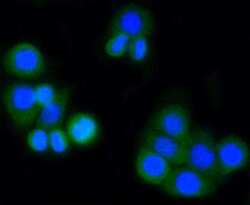
- Experimental details
- Immunocytochemical analysis of MMP14 in CRC cells using a MMP14 Monoclonal antibody (Product # MA5-32076) as seen in green. The nuclear counter stain is DAPI (blue). Cells were fixed in paraformaldehyde, permeabilised with 0.25% Triton X100/PBS.
- Submitted by
- Invitrogen Antibodies (provider)
- Main image
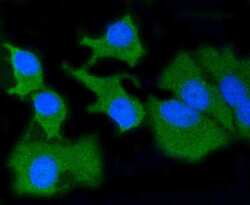
- Experimental details
- Immunocytochemical analysis of MMP14 in BT-20 cells using a MMP14 Monoclonal antibody (Product # MA5-32076) as seen in green. The nuclear counter stain is DAPI (blue). Cells were fixed in paraformaldehyde, permeabilised with 0.25% Triton X100/PBS.
- Submitted by
- Invitrogen Antibodies (provider)
- Main image
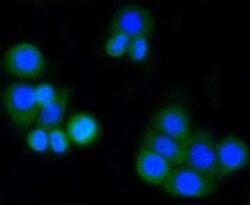
- Experimental details
- Immunocytochemical analysis of MMP14 in CRC cells using a MMP14 Monoclonal antibody (Product # MA5-32076) as seen in green. The nuclear counter stain is DAPI (blue). Cells were fixed in paraformaldehyde, permeabilised with 0.25% Triton X100/PBS.
- Submitted by
- Invitrogen Antibodies (provider)
- Main image
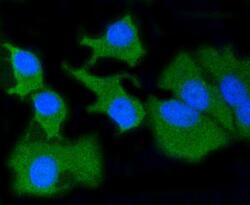
- Experimental details
- Immunocytochemical analysis of MMP14 in BT-20 cells using a MMP14 Monoclonal antibody (Product # MA5-32076) as seen in green. The nuclear counter stain is DAPI (blue). Cells were fixed in paraformaldehyde, permeabilised with 0.25% Triton X100/PBS.
Supportive validation
- Submitted by
- Invitrogen Antibodies (provider)
- Main image
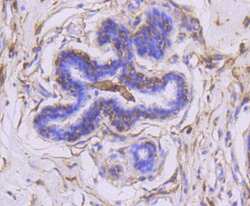
- Experimental details
- Immunohistochemical analysis of MMP14 of paraffin-embedded Human breast carcinoma tissue using a MMP14 Monoclonal antibody (Product #MA5-32076). Counter stained with hematoxylin.
- Submitted by
- Invitrogen Antibodies (provider)
- Main image
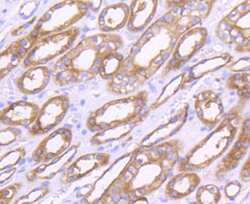
- Experimental details
- Immunohistochemical analysis of MMP14 of paraffin-embedded Human kidney tissue using a MMP14 Monoclonal antibody (Product #MA5-32076). Counter stained with hematoxylin.
- Submitted by
- Invitrogen Antibodies (provider)
- Main image
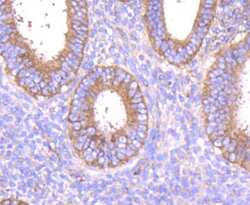
- Experimental details
- Immunohistochemical analysis of MMP14 of paraffin-embedded Human uterus tissue using a MMP14 Monoclonal antibody (Product #MA5-32076). Counter stained with hematoxylin.
Supportive validation
- Submitted by
- Invitrogen Antibodies (provider)
- Main image
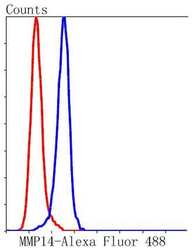
- Experimental details
- Flow Cytometric analysis of MMP14 in A549 cells using a MMP14 Monoclonal Antibody (Product # MA5-32076) at a dilution of 1:50, as seen in blue compared with an unlabelled control (cells without incubation with primary antibody; red). Alexa Fluor 488-conjugated goat anti rabbit IgG was used as the secondary antibody.
- Submitted by
- Invitrogen Antibodies (provider)
- Main image
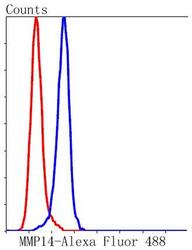
- Experimental details
- Flow Cytometric analysis of MMP14 in A549 cells using a MMP14 Monoclonal Antibody (Product # MA5-32076) at a dilution of 1:50, as seen in blue compared with an unlabelled control (cells without incubation with primary antibody; red). Alexa Fluor 488-conjugated goat anti rabbit IgG was used as the secondary antibody.
Supportive validation
- Submitted by
- Invitrogen Antibodies (provider)
- Main image
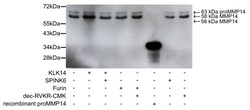
- Experimental details
- Figure 6 Processing of cell surface proMMP14 by KLK14. Murine fibroblasts stably expressing human MMP14 (MT1-MMP) were treated with KLK14 and furin. Selective inhibitors serine protease inhibitor Kazal-type 6 (SPINK6) (KLK14) and dec-RVKR-CMK (furin) were used to inhibit KLK and furin in the control samples. Cell surface proteins were then biotinylated, and streptavidin bead immunoprecipitates were subjected to immunoblotting using an anti-MMP14 antibody. Each sample contained the 63 kDa proMMP14 form, whereas an increase in the active 58 kDa MMP14 form was observed after KLK14 incubation. Additionally, a lower molecular weight MMP14 form at 56 kDa was detected only in the KLK14 treated sample. KLK = kallikrein-related peptidase; MMP = matrix metalloproteinase.
 Explore
Explore Validate
Validate Learn
Learn Western blot
Western blot Immunocytochemistry
Immunocytochemistry